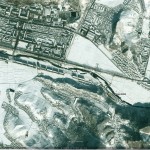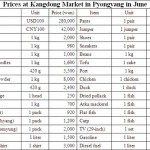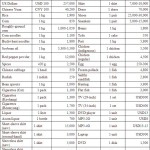Pictured above (Google Earth): The Kangdong Market (39.134801°, 126.109387°)
According to the Daily NK:
It has been revealed that the cost of living in Pyongyang has more or less held steady over the past month, despite a modest decrease in rice prices.
According to sources in Pyongyang, one kilogram of rice is trading for about 1,900 North Korean won, which represents a fall of about 100 won on June prices. It is thought that a modest easing of the exchange rate of North Korean Won against Chinese Yuan and the importation of a large amount of rice from China are partially responsible for the change.
“Chinese rice is currently selling for roughly 200-300 won less than Chosun (North Korea) rice,” one source said, explaining, “Chinese merchants and the like brought the rice into the country en masse at the start of the year when the price of rice was rising, but now it’s not selling so well. The price of rice has fallen across the broad and is fluctuating at around the 2,000 won mark.”
At the end of January, the price of a kilogram of rice temporarily soared past the 3,000 won mark. There was some speculation at the time that wholesalers were colluding to raise prices. After the price went up, a natural increase in market supply and a drop in purchasing power from currency redenomination kicked in to force prices back down. Since then it has more or less stabilized at around the 2,000 won per kilogram mark again.
The price for corn, which usually trades for about half the price of rice, has also recorded a small fall to 850 won per kilogram, down 130 won on last month’s prices. Pork prices are stable at 5,800 won per kilogram, which is the same price as last month.
Moreover, second-hand clothes are showing brisk trade on the market. One source attributed their popularity to the fact that they sell for less than half the price of new clothes.
Additionally, the source claimed that the warmer weather is encouraging more people to purchase sleeveless and short-sleeve shirts, as well as shorts and skirts. “Sleeveless shirts are prohibited by the authorities, so people only wear them at home. Mostly young people are doing this,” he said.
“Short-sleeve shirts, shorts and skirts are selling like hotcakes as well, but it is required that the latter two items go down past the knees.”
The cost of living in North Korea has more or less returned to the levels they were at before the currency redenomination. It is business as usual at the jangmadang, but with trade volume well down from what it was before. The source explained that, while people are not holding onto cash as a result of the currency revaluation, it is only food items and lifestyle goods that are selling relatively well, while sales of high-ticket electronic goods have actually decreased.
Here is the price data collected from the Kangdong Market on the outskirts of Pyongyang (JPG):
Left: June 2011, Right: July 2011
Links to the discussion of North Korea’s food crisis can be found here.
Read the full story here:
Market Prices Stable, Sleeveless Shirts Popular
Daily NK
Choi Cheong Ho and Park Sung Kook
2011-7-20



